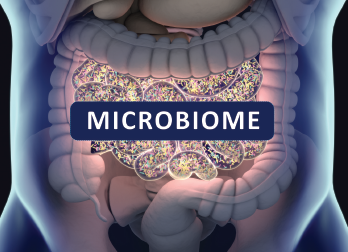
Anatomy Insider / shutterstock.com
CHICAGO—The world of rheumatology is beginning to harness the promise of the microbiome, with evidence showing components of the gut may help predict response to medication and may be manipulated to improve how well a treatment works, said Jose Scher, MD, at the 2019 ACR State-of-the-Art Clinical Symposium, held April 5–7.
“We can truly exploit or employ the microbiome as predictors of response,” said Dr. Scher, director of the Microbiome Center for Rheumatology and Autoimmunity at New York University. “We can [also] manipulate the microbiome.” That may lead to new therapeutic approaches.
The sheer enormity of the microbe population is a factor that bodes well for useful applications in rheumatology treatment, Dr. Scher said. One hundred trillion microbial cells live in and around the human body, and they encode for about 3 million genes. Yet only about 20,000 genes exist in the human body. Therefore, the genetic makeup of the microbiome dwarfs that of humans by a factor of more than 100.
Although scientists are not capable of culturing about 80% of bacteria in the microbiome—because the nutritional and oxygen requirements, for example, are unknown—it’s possible to gather a sample of stool or skin and determine every taxa in that sample, amplify those genes and ask what function those genes perform, Dr. Scher said. One of the central functions of the human microbiome is shaping the gut immune system and creating a defense against pathogens.
Dr. Scher’s lab has examined a range of rheumatologic diseases, including rheumatoid arthritis, psoriatic arthritis and ankylosing spondylitis, finding corresponding abnormalities in the microbiome.1
“In every single one of the cases [in which] we see chronic inflammation, we see something we’ve described as dysbiosis”—in which the composition of microbiome falls out of balance, he said.
Pharmacomicrobiomics
Researchers have found dietary fibers are converted by microbes into short-chain fatty acids, and regulatory T cells with receptors for these fatty acids reside in the lamina propria of the gut, thereby helping suppress inflammatory responses.2 Researchers have also found in studies of germ-free mice in which regulatory T cells had been depleted the T cells could be reconstituted with short-chain fatty acids.3
This insight is important to potentially harness of the microbiome’s function, Dr. Scher noted. “Microbes are important, but more relevant is the fact they produce immunomodulatory metabolites,” he said. “Can we modify chronic inflammatory disease, in whichever form, by incorporating some of these immunomodulators?
“It follows that you can take some of our drugs or some of our dietary components and biotransform [them] into something different,” he added. This idea has come to be known as pharmacomicrobiomics.
‘Based on our model, can we categorize who’s going to be a responder? In every single case, we could predict whether or not [a patient would have a] low response or very high response [to methotrexate].’ —Jose Scher, MD
“[Host] genes are, for the most part, non-modifiable,” Dr. Scher said. “The human microbiome is entirely modifiable,” with diet and antibiotics, by chronic diseases and by many other influences.
“What it means for translational medicine is that now you may have a way to take certain aspects of the microbiome and modify it in such a way that it’s either beneficial or prevents potential damage [from drugs used to treat rheumatic diseases],” he said.
Ongoing Research
In his lab, Dr. Scher and colleagues are putting these ideas to the test. Knowing that methotrexate requires certain enzymes to be polyglutamated, so it can become biologically active, they looked at baseline features of the microbiota of responders and non-responders to methotrexate.
The researchers found that if patients who were non-responders four months into treatment had significantly higher levels of the activating enzyme known as folylpolyglutamate synthase, the drug was essentially processed in the microbiome before it could be processed therapeutically. Using levels of the enzyme as a predictor has yielded a robust capacity for prediction of response. Results for 10 patients were encouraging, Dr. Scher said.
“Based on our model, can we categorize who’s going to be a responder?” he asked. “In every single case, we could predict whether or not they [would have a] low response or very high response.”
Armed with this knowledge, clinicians may be able to boost a patient’s response to treatment by incorporating microbes that may help guard against this premature metabolizing of the drug, allowing it to be properly absorbed.
Another approach being pursued is transplantation of fecal material from responders and non-responders into germ-free animals to determine whether responses can be manipulated. The goal is to try to improve upon the all-important goal of early response, Dr. Scher said.
“The whole idea now is to shift the field and try to use the microbiota in this precision medicine era,” he said. “It’s happening, and we are lucky that we have all of this science behind it.”
Now we can incorporate what we’ve learned into the treatment of rheumatic diseases.
Thomas R. Collins is a freelance writer living in South Florida.
References
- Scher J. The microbiome in psoriasis and psoriatic arthritis: Joints. J Rheumatol Suppl. 2018 Jun;94:32–35.
- Zhang M, Zhou Q, Dorfman RG, et al. Butyrate inhibits interleukin-17 and generates Tregs to ameliorate colorectal colitis in rats. BMC Gastroenterol. 2016 Jul 30;16(1):84.
- Smith PM, Howitt MR, Panikov N, et al. The microbial metabolites, short-chain fatty acids, regulate colonic Treg cell homeostasis. Science. 2013 Aug 2;341(6145):569–573.


